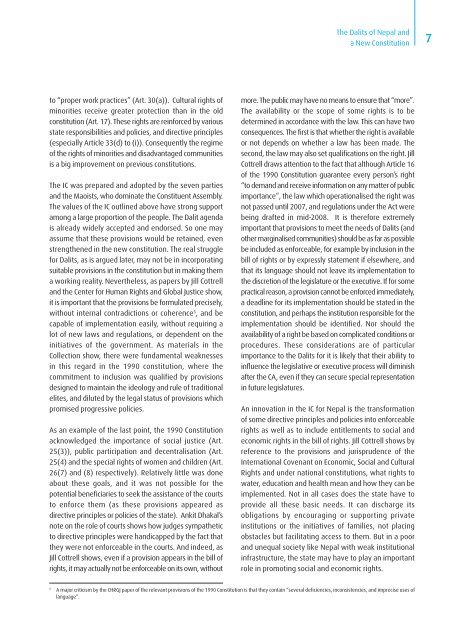The Dalits of Nepal and a New Constitution - ConstitutionNet
The Dalits of Nepal and a New Constitution - ConstitutionNet
The Dalits of Nepal and a New Constitution - ConstitutionNet
You also want an ePaper? Increase the reach of your titles
YUMPU automatically turns print PDFs into web optimized ePapers that Google loves.
<strong>The</strong> <strong>Dalits</strong> <strong>of</strong> <strong>Nepal</strong> <strong>and</strong><br />
a <strong>New</strong> <strong>Constitution</strong><br />
7<br />
to “proper work practices” (Art. 30(a)). Cultural rights <strong>of</strong><br />
minorities receive greater protection than in the old<br />
constitution (Art. 17). <strong>The</strong>se rights are reinforced by various<br />
state responsibilities <strong>and</strong> policies, <strong>and</strong> directive principles<br />
(especially Article 33(d) to (i)). Consequently the regime<br />
<strong>of</strong> the rights <strong>of</strong> minorities <strong>and</strong> disadvantaged communities<br />
is a big improvement on previous constitutions.<br />
<strong>The</strong> IC was prepared <strong>and</strong> adopted by the seven parties<br />
<strong>and</strong> the Maoists, who dominate the Constituent Assembly.<br />
<strong>The</strong> values <strong>of</strong> the IC outlined above have strong support<br />
among a large proportion <strong>of</strong> the people. <strong>The</strong> Dalit agenda<br />
is already widely accepted <strong>and</strong> endorsed. So one may<br />
assume that these provisions would be retained, even<br />
strengthened in the new constitution. <strong>The</strong> real struggle<br />
for <strong>Dalits</strong>, as is argued later, may not be in incorporating<br />
suitable provisions in the constitution but in making them<br />
a working reality. Nevertheless, as papers by Jill Cottrell<br />
<strong>and</strong> the Center for Human Rights <strong>and</strong> Global Justice show,<br />
it is important that the provisions be formulated precisely,<br />
without internal contradictions or coherence 5 , <strong>and</strong> be<br />
capable <strong>of</strong> implementation easily, without requiring a<br />
lot <strong>of</strong> new laws <strong>and</strong> regulations, or dependent on the<br />
initiatives <strong>of</strong> the government. As materials in the<br />
Collection show, there were fundamental weaknesses<br />
in this regard in the 1990 constitution, where the<br />
commitment to inclusion was qualified by provisions<br />
designed to maintain the ideology <strong>and</strong> rule <strong>of</strong> traditional<br />
elites, <strong>and</strong> diluted by the legal status <strong>of</strong> provisions which<br />
promised progressive policies.<br />
As an example <strong>of</strong> the last point, the 1990 <strong>Constitution</strong><br />
acknowledged the importance <strong>of</strong> social justice (Art.<br />
25(3)), public participation <strong>and</strong> decentralisation (Art.<br />
25(4) <strong>and</strong> the special rights <strong>of</strong> women <strong>and</strong> children (Art.<br />
26(7) <strong>and</strong> (8) respectively). Relatively little was done<br />
about these goals, <strong>and</strong> it was not possible for the<br />
potential beneficiaries to seek the assistance <strong>of</strong> the courts<br />
to enforce them (as these provisions appeared as<br />
directive principles or policies <strong>of</strong> the state). Ankit Dhakal’s<br />
note on the role <strong>of</strong> courts shows how judges sympathetic<br />
to directive principles were h<strong>and</strong>icapped by the fact that<br />
they were not enforceable in the courts. And indeed, as<br />
Jill Cottrell shows, even if a provision appears in the bill <strong>of</strong><br />
rights, it may actually not be enforceable on its own, without<br />
more. <strong>The</strong> public may have no means to ensure that “more”.<br />
<strong>The</strong> availability or the scope <strong>of</strong> some rights is to be<br />
determined in accordance with the law. This can have two<br />
consequences. <strong>The</strong> first is that whether the right is available<br />
or not depends on whether a law has been made. <strong>The</strong><br />
second, the law may also set qualifications on the right. Jill<br />
Cottrell draws attention to the fact that although Article 16<br />
<strong>of</strong> the 1990 <strong>Constitution</strong> guarantee every person’s right<br />
“to dem<strong>and</strong> <strong>and</strong> receive information on any matter <strong>of</strong> public<br />
importance”, the law which operationalised the right was<br />
not passed until 2007, <strong>and</strong> regulations under the Act were<br />
being drafted in mid-2008. It is therefore extremely<br />
important that provisions to meet the needs <strong>of</strong> <strong>Dalits</strong> (<strong>and</strong><br />
other marginalised communities) should be as far as possible<br />
be included as enforceable, for example by inclusion in the<br />
bill <strong>of</strong> rights or by expressly statement if elsewhere, <strong>and</strong><br />
that its language should not leave its implementation to<br />
the discretion <strong>of</strong> the legislature or the executive. If for some<br />
practical reason, a provision cannot be enforced immediately,<br />
a deadline for its implementation should be stated in the<br />
constitution, <strong>and</strong> perhaps the institution responsible for the<br />
implementation should be identified. Nor should the<br />
availability <strong>of</strong> a right be based on complicated conditions or<br />
procedures. <strong>The</strong>se considerations are <strong>of</strong> particular<br />
importance to the <strong>Dalits</strong> for it is likely that their ability to<br />
influence the legislative or executive process will diminish<br />
after the CA, even if they can secure special representation<br />
in future legislatures.<br />
An innovation in the IC for <strong>Nepal</strong> is the transformation<br />
<strong>of</strong> some directive principles <strong>and</strong> policies into enforceable<br />
rights as well as to include entitlements to social <strong>and</strong><br />
economic rights in the bill <strong>of</strong> rights. Jill Cottrell shows by<br />
reference to the provisions <strong>and</strong> jurisprudence <strong>of</strong> the<br />
International Covenant on Economic, Social <strong>and</strong> Cultural<br />
Rights <strong>and</strong> under national constitutions, what rights to<br />
water, education <strong>and</strong> health mean <strong>and</strong> how they can be<br />
implemented. Not in all cases does the state have to<br />
provide all these basic needs. It can discharge its<br />
obligations by encouraging or supporting private<br />
institutions or the initiatives <strong>of</strong> families, not placing<br />
obstacles but facilitating access to them. But in a poor<br />
<strong>and</strong> unequal society like <strong>Nepal</strong> with weak institutional<br />
infrastructure, the state may have to play an important<br />
role in promoting social <strong>and</strong> economic rights.<br />
5<br />
A major criticism by the CHRGJ paper <strong>of</strong> the relevant provisions <strong>of</strong> the 1990 <strong>Constitution</strong> is that they contain “several deficiencies, inconsistencies, <strong>and</strong> imprecise uses <strong>of</strong><br />
language”.








![g]k fnsf blntx? / gofF ;+l jwfg](https://img.yumpu.com/49483602/1/184x260/gk-fnsf-blntx-goff-l-jwfg.jpg?quality=85)



![+ljwfg;ef, /fHosf]k'g](https://img.yumpu.com/41604075/1/184x260/-ljwfgef-fhosfkg.jpg?quality=85)




